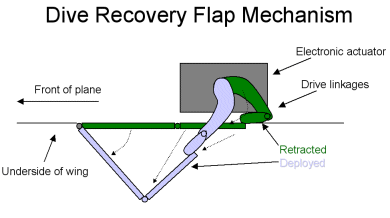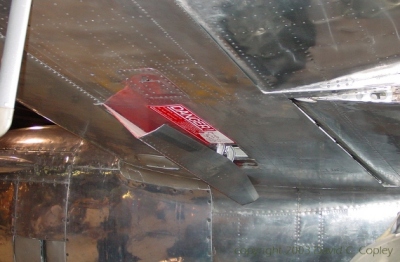As noted in another reply, the only way you'll see the dive flaps deploy is if you're on the runway and hit F3 and look under the plane as you deploy them. You will not see them deploy sitting in the cockpit.
I also didn't notice any performance change in or out of a dive when trying to deploy them via Shift C key, thought the cockpit indicator does light up and go off with each press of the key.
The dive flaps work as intended and will assist in recovering from a high speed dive. The problem with a lot of players is that they usually deploy and use the dive flaps incorrectly. A lot think that the flaps are intended to help you recover from a dive by acting as a brake and slowing your plane down enough that you can pull out of a dive. That is 100% incorrect. As you can see in the diagram below and in the photo with the dive flaps deployed, the dive flaps are a very inefficient design to act as a dive brake, why? Well, that's an easy answer because the dive flaps weren't designed to act as brakes but instead as someone else mentioned to change the airflow over the leading edge of the wings.


For the dive flaps to work properly, you need to be in a certain window where they are beneficial to get the most out of them. The dive flaps only work at high speeds, they are pretty much useless at speeds below 350mph IAS and you won't see any real effect if you deploy them at speeds lower than that. The best time to deploy the flaps is when you're about to enter the dive, though you can sometimes get away with deploying them shortly after you've started your dive. New or inexperienced P-38 drivers tend to deploy the flaps at the onset of a high speed buffet and by that time it's usually too late and the dive flaps aren't as effective and you'll need to manually trim to recover. As soon as you complete your dive recovery, retract the dive flaps.
A little trick you can do with the dive flaps that was used by real life P-38 drivers. The dive flaps can aid in high speed turns, just deploy them at the start of the turn and retract them as you finish the turn.
Now the brutal honest truth...if you have to deploy the dive flaps to recover you messed up. It's that simple. Properly flown, the P-38 (all models) can safely dive if you understand what compressability is and how it effects the P-38 without neediing to use dive flaps. Remember, compressability happens when the air over the leading edge of the wing reaches critical mach speeds, which means the higher you fly the P-38, the increased risk of entering compressability in a dive. The lower you fly the P-38, the risk decreases dramatically the lower in altitude you go. In other words, the P-38
will not enter into a compresability state below 20,000ft, the air is too thick for the air over the leading edge to reach critical mach. The P-38 will suffer from sluggish and hard controls below 20,000ft but that is due to regulary aerodynamic forces pushing on the control surfaces and not the phenomena that is compressability.
To safely dive the P-38, you need to control your speed and you can do that by decreasing throttle and using your rudders to "skid" the plane in the dive. Using this simple technique you can easily reach speeds up to 475mph IAS in a dive and still retain control (although sluggish) to pull up out of the dive without having to use dive flaps.
I don't notice it either but I just deploy it when landing.
Why? They don't do anything at low speeds and even if they did wouldn't be smart to deploy them on landing. Besides, you don't need flaps to land a P-38.
ack-ack